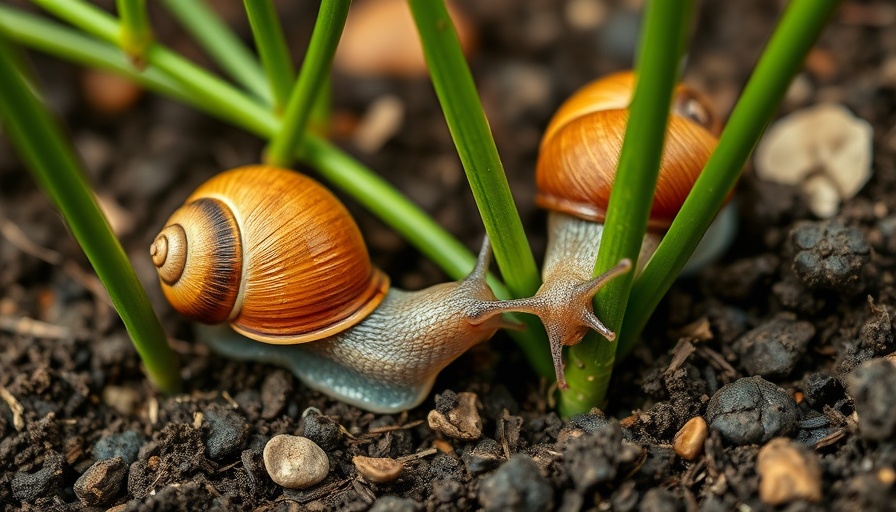
Unwelcome Garden Guests: Understanding Slugs and Snails
April showers bring beautiful blooms, but they also usher in the unwelcome presence of slugs and snails—those notorious garden raiders. These slimy creatures can wreak havoc on your beloved plants, feasting on silky blossoms, soft greens, and even ripening fruits. To get ahead of these nighttime marauding munchers, understanding their habits is essential.
The Secret Life of Slugs and Snails
Both slugs and snails belong to the mollusk family, sharing similar biology and ecological niches. While snails are identifiable by their spiraled shells, slugs are somewhat more elusive, lacking this armor yet exhibiting a similar slippery gait, propelled by a moist muscular foot. Their favorite habitats are the cool, dark nooks of a home garden, making them particularly active at night or on humid days. During dry spells, they might hunker down to survive, rendering more extensive damage when they emerge as the sun sets or after rains.
Effective Strategies to Control Slug and Snail Populations
Those looking to end the reign of slugs and snails in their gardens must employ a mix of tactics tailored to combat these impactful pests. Here are several proven methods to consider:
- Handpicking: This simplest and most immediate tactic involves manually removing slugs and snails from your plants during the evening or early morning when they are most active.
- Baiting and Trapping: Set out traps using beer, which attracts slugs and snails, leading them to a watery demise, thus reducing their numbers.
- Barrier Methods: Physical barriers can efficiently deter these pests. Copper tape, for instance, creates a small electric shock that discourages slugs from crossing it, while sharp sands or diatomaceous earth can be applied around plants.
- Natural Predators: Encouraging wildlife that naturally preys on slugs and snails is a fantastic way to create a balanced ecosystem in your garden. Birds and certain beetles are known to be voracious slug hunters!
Gardening Hacks: Preventative Measures to Deter Pests
Creating an inhospitable environment for slugs and snails starts with understanding your planting strategies. Here are a few gardening hacks to keep in mind:
- Pest-Resistant Plants: Consider incorporating plants that are known to deter slugs and snails, such as lavender, rosemary, or sage.
- Healthy Soil Practices: By maintaining healthy soil through composting and the use of organic fertilizers, you foster robust plants that can withstand pest attacks more effectively.
- Layering Your Garden: Utilize a multi-layered approach to garden design, bringing shade plants into the mix, so slugs can't easily find their way to your prized vegetables.
What the Future Holds for Gardening
As climate change continues to alter ecosystems, adapting certain gardening practices will become increasingly crucial. Innovations in garden design, eco-friendly pest control methods, and sustainable plant choices will empower gardeners to protect their green spaces effectively. While slugs and snails may always exist in some form, with strategic planning and mindfulness, we can continue to cultivate flourishing gardens.
Join the Conversation
As you embark on your gardening journey, don't just protect your greens; become part of a larger community dedicated to sustainable living. Share your experiences and discoveries with friends or on social media. Together, we can create a wealth of knowledge on how to tackle these squishy nuisances while fostering the growth of exquisite plants and beautiful outdoor spaces.
From slugs to sunflowers, every detail matters in your quest for a healthier garden. So roll up your sleeves, get inspired, and embrace the beauty of gardening while safeguarding against pests.
 Add Row
Add Row  Add
Add 




 Add Row
Add Row  Add
Add 

Write A Comment